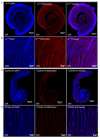COX4-like, a Nuclear-Encoded Mitochondrial Gene Duplicate, Is Essential for Male Fertility in Drosophila melanogaster
- PMID: 35327978
- PMCID: PMC8950493
- DOI: 10.3390/genes13030424
COX4-like, a Nuclear-Encoded Mitochondrial Gene Duplicate, Is Essential for Male Fertility in Drosophila melanogaster
Abstract
Recent studies on nuclear-encoded mitochondrial genes (N-mt genes) in Drosophila melanogaster have shown a unique pattern of expression for newly duplicated N-mt genes, with many duplicates having a testis-biased expression and playing an essential role in spermatogenesis. In this study, we investigated a newly duplicated N-mt gene-i.e., Cytochrome c oxidase 4-like (COX4L)-in order to understand its function and, consequently, the reason behind its retention in the D. melanogaster genome. The COX4L gene is a duplicate of the Cytochrome c oxidase 4 (COX4) gene of OXPHOS complex IV. While the parental COX4 gene has been found in all eukaryotes, including single-cell eukaryotes such as yeast, we show that COX4L is only present in the Brachycera suborder of Diptera; thus, both genes are present in all Drosophila species, but have significantly different patterns of expression: COX4 is highly expressed in all tissues, while COX4L has a testis-specific expression. To understand the function of this new gene, we first knocked down its expression in the D. melanogaster germline using two different RNAi lines driven by the bam-Gal4 driver; second, we created a knockout strain for this gene using CRISPR-Cas9 technology. Our results showed that knockdown and knockout lines of COX4L produce partial sterility and complete sterility in males, respectively, where a lack of sperm individualization was observed in both cases. Male infertility was prevented by driving COX4L-HA in the germline, but not when driving COX4-HA. In addition, ectopic expression of COX4L in the soma caused embryonic lethality, while overexpression in the germline led to a reduction in male fertility. COX4L-KO mitochondria show reduced membrane potential, providing a plausible explanation for the male sterility observed in these flies. This prominent loss-of-function phenotype, along with its testis-biased expression and its presence in the Drosophila sperm proteome, suggests that COX4L is a paralogous, specialized gene that is assembled in OXPHOS complex IV of male germline cells and/or sperm mitochondria.
Keywords: COX4L; CRISPR knockout; Drosophila melanogaster; gene duplication; nuclear-encoded mitochondrial gene; spermatogenesis.
Conflict of interest statement
The authors declare no conflict of interest.
Figures




Similar articles
-
Few Nuclear-Encoded Mitochondrial Gene Duplicates Contribute to Male Germline-Specific Functions in Humans.Genome Biol Evol. 2017 Oct 1;9(10):2782-2790. doi: 10.1093/gbe/evx176. Genome Biol Evol. 2017. PMID: 28985295 Free PMC article.
-
Testis- and ovary-expressed polo-like kinase transcripts and gene duplications affect male fertility when expressed in the Drosophila melanogaster germline.G3 (Bethesda). 2025 Jan 8;15(1):jkae273. doi: 10.1093/g3journal/jkae273. G3 (Bethesda). 2025. PMID: 39566185 Free PMC article.
-
Mammalian heat shock protein A4 family ortholog Hsc70Cb is required for two phases of spermatogenesis in D. melanogaster.Reproduction. 2025 Mar 7;169(4):e240458. doi: 10.1530/REP-24-0458. Print 2025 Apr 1. Reproduction. 2025. PMID: 39991973
-
Drosophila melanogaster Mitochondrial Carriers: Similarities and Differences with the Human Carriers.Int J Mol Sci. 2020 Aug 22;21(17):6052. doi: 10.3390/ijms21176052. Int J Mol Sci. 2020. PMID: 32842667 Free PMC article. Review.
-
Duplicated proteasome subunit genes in Drosophila and their roles in spermatogenesis.Heredity (Edinb). 2009 Jul;103(1):23-31. doi: 10.1038/hdy.2009.23. Epub 2009 Mar 11. Heredity (Edinb). 2009. PMID: 19277057 Review.
Cited by
-
Functional innovation through new genes as a general evolutionary process.Nat Genet. 2025 Feb;57(2):295-309. doi: 10.1038/s41588-024-02059-0. Epub 2025 Jan 28. Nat Genet. 2025. PMID: 39875578 Review.
-
Retrogene Duplication and Expression Patterns Shaped by the Evolution of Sex Chromosomes in Malaria Mosquitoes.Genes (Basel). 2022 May 28;13(6):968. doi: 10.3390/genes13060968. Genes (Basel). 2022. PMID: 35741730 Free PMC article.
-
Evolutionary New Genes in a Growing Paradigm.Genes (Basel). 2022 Sep 8;13(9):1605. doi: 10.3390/genes13091605. Genes (Basel). 2022. PMID: 36140774 Free PMC article.
-
Mitochondrial Differentiation during Spermatogenesis: Lessons from Drosophila melanogaster.Int J Mol Sci. 2024 Apr 3;25(7):3980. doi: 10.3390/ijms25073980. Int J Mol Sci. 2024. PMID: 38612789 Free PMC article. Review.
References
Publication types
MeSH terms
Substances
Grants and funding
LinkOut - more resources
Full Text Sources
Medical
Molecular Biology Databases
Research Materials
Miscellaneous

